Choose Your September Pitchers Wisely
We’ve officially entered championship month and whether you’re in head-to-head playoffs or accumulating your way to the money in roto, our starting choices deserve a larger microscope. Choosing who to start and sit, whether stud or streamer, can have profound implications, with razor-thin margins in a category or two, often separating the ultimate winners and losers. And given the desire to manipulate particular categories, it’s not as simple as needing “good” starts because you might be in a situation where any start that ends with a win (or a strikeout per IP, zeroed ratios, etc) is good, and any start that doesn’t is bad, regardless of the other results.
With that in mind, let’s stay ninja focused on the minutiae that gives us the best chance of putting a thumb on the baseball god’s scale of justice, trying to avoid ratio landmines while pulling rabbits out of the wavier wire hat. To that end, we’ll look at how teams have performed overall, in a variety of categories, as well as against the different hands, while also comparing more recent results to those further in the past. And we’ll check in on how teams do versus individual pitch types from each side of the mound, mixing, matching, or avoiding, the pitchers with mixes that seem less than ideal.
We’ll also include plenty of pretty pictures to better illustrate the relative differences between team performance but I’d like to keep the focus of commentary on how to best use the data. Well, at least, I’d like to demonstrate how I look at things when evaluating individual starts to better help you use the charts for your own devices going forward. Things will change from now until October but we’re at the point in the season where I’m confident they won’t so much as to make today’s charts completely outdated in a week. Hopefully, going through my thought process will help you with yours.
Okay, that is way too much preamble (and way too many consecutive paragraphs starting with a W), so let’s get digging in, starting with how teams have ranked in 2022, with all stats up until September 1.
Ordered by overall rank in wOBA, here are the team ranks in wOBA and xwOBA, vs RHP, LHP, and overall.
Alright, this gives us a good snapshot of how team offenses have fared overall and against each hand of pitchers. But let’s also look at those same numbers in a different arrangement, to note how team wOBA has matched up with expected wOBA through five months.
Here are the same team ranks but with the columns flipped to show wOBA/xwOBA vs LHP, RHP, and all hands:
The first thing to mention is to not get too stressed out by smaller gaps in rank. We’re now dealing with a large enough sample that a few spots between wOBA and xwOBA aren’t telling you much. If there was a gap of 20 spots, then sure, take note. But we’re looking at the biggest difference being nine spots (Kansas City, Colorado), with 20 teams having a difference of fewer than five spots and 10 teams having but one or none…
Behold! The power of xwOBA tends to help wOBA find its level as the season progresses.
Expected stats aren’t the end-all, be-all and I understand that some baseball fans still have no use for the modern proclivities of putting any weight towards the ethereal events that launch angles and exit velocity say could have occurred, instead wanting to only judge what actually did. But, for me, xwOBA (and xwOBAcon) point towards how players are generally swinging the bat, regardless of outcomes. Baseball isn’t always a math problem and thus I don’t think you need to drill down into every reason for why – but you show me a hitter with a .300 wOBA/.400 xwOBA, and I’ll show you a hitter that has sowed better balls than what has been reaped.
This goes the same for team results, as for individuals, but the difference is the massive sample size we get to use, with most teams nearing 5000 PA by this point in the season. With so many opportunities, the truth of a team’s offense is harder to hide in the tea leaves of expected versus actual. And when looking at all of the information on the chart above, we can suss out the most useful nuggets for properly judging an offense for matchup purposes, deciding what can be trusted and what should be questioned.
Take Milwaukee, for example, which has virtually no gap between their overall wOBA (9th) and xwOBA (8th). Okay, so the only thing we can take from that is that they’ve been a top-10 offense by results and with x-stats that say we should believe them. Not super helpful. Neither are the gaps vs RHP (2nd/5th) and LHP (25th/21st), with the small differences only speaking to the reliability. Our real takeaway should be that the Brewers are not only much worse vs LHP but that their expected results back up the magnitude of the difference.
Given their +4900 PA in 2022, can we say the Brewers are a top-10 offense? I think so, they’re 9th in wOBA, 8th in xwOBA, and 11th in runs scored. Are the Brewers a top-five offense vs RHP? Yes, they’re 2nd in wOBA, 5th in xwOBA, and 6th in runs scored. But are they a bottom-10 offense vs LHP? Also, yes! They’re 25th in wOBA, 21st in xwOBA, and 24th in runs scored. That’s not to say you should be sitting all of your right-handers and starting any left-hander against the Crew but the wise fantasy manager should let the above inform their start/sit decisions.
Taking our example with Milwaukee further, the Brewers have eight games in Week 22, with a makeup doubleheader vs San Francisco sandwiched between a series at home against Cincinnati and on the road in Colorado. Surely, you’re not streaming any Rockies at home, even if Kyle Freeland is left-handed. And Sean Hjelle, a right-handed rookie from San Francisco with 6 IPs also probably won’t be considered a reasonable option. Jakob Junis could be, though, as he’s been a popular streamer when healthy, albeit with mixed results. But given how Milwaulkee handles righties, as well as how they handle his pitch mix (which we’ll get to shortly) in particular, would make me very wary about handing Junis a September stream.
How teams rank in wOBA and xwOBA, versus RHP and LHP, is only the start of our matchups onion, though. To get even more dialed in selecting our starts and sits, we’re also going to look at results by half (to judge hotness versus notness), adding ranks in wOBA (and xwOBA) on contact, K%, SwStr%, BB%, and GB%. These will better clue us into not just overall offense but how the ball-striking and whiff rates have been going.
We can also peel things down even further to the pitch-type level, again using handedness as our guide. Going back to the streaming possibility of Junis vs MIL, we should already be wary of streaming a right-hander against a Brewers team that has been a top-five offense vs RHP. But going further, Junis and his pitch mix (sinker/slider/changeup) don’t seem set up for success against Milwaukee:

After Junis, the Brewers have a series against Cincinnati and two Reds right-handers (Chase Anderson, and Justin Dunn) probably shouldn’t be on your radar. But Friday’s scheduled starter, Nick Lodolo, fulfills our initial bill of being left-handed, so we’re off to a good start. And he also works with a sinker/changeup/curveball pitch mix that seems like it will line up well against Milwaukee:

Okay, great! Unfortunately, though, I also made this same argument the last time Lodolo faced the Brewers on August 6, and the results were ho-hum, at best (4.2 IP – 3 ER – 4 K). But this is about putting yourself in the best position to accomplish your goals and sometimes things don’t work out. And I wouldn’t be deterred* if a sneaky stream from Lodolo could serve my categorical needs.
*I watched this game and didn’t think Lodolo looked too bad through three innings (1 H, 2 BB, 2 K) before falling apart in the fourth, allowing home runs to Andrew McCutchen and Keston Hiura.
Alright, let’s peel down to the next layer, this time chopping the ranks into the first half and second half. Hot! Not! Middle!
Still ordered by overall wOBA (and also including overall xwOBA), here are the team ranks vs RHP, LHP, and overall, split into 1st half/2nd half. Overall ranks for 2022 are included on the left as a point of reference:
Now things are getting a little more interesting, as we can see some teams from the first half that have sunk or risen to new levels. But these changes can have many reasons behind them, whether its luck running out/catching up, or team compositions shifting due to injuries and/or trade. And when splitting things up by halves and handedness, we can better assess which drops in performance are about overall struggles and which might be segmented.
Let’s go step-by-step with some examples of teams that have seen significant changes to their rankings between halves:
New York Yankees
2022: 5th in wOBA, 2nd in xwOBA
Those are both good! I don’t see what all of the grousing is about.
1st half: 1st in wOBA, 1st in xwOBA
2nd half: 21st in wOBA, 11th in xwOBA
Oh, now I get it. But while going from the top of the wOBA heap to hanging with the likes of Kansas City and Oakland isn’t ideal, ranking 11th in xwOBA makes for a far less precipitous drop. But struggles are still struggles even if they’re lesser on the expected front, so let’s look at how the Yankees have fared by hand.
VS LHP
1st half: 4th in wOBA, 7th in xwOBA
2nd half: 3rd in wOBA, 7th in xwOBA
I feel like we can agree on the problems in the Bronx not having much to do with facing left-handers. That only leaves…
VS RHP
1st half: 2nd in wOBA, 1st in xwOBA
2nd half: 25th in wOBA, 14th in xwOBA
There it is. New York dropping from 1st in the first half for wOBA, to 21st in the second half seems to be just a righty problem. But on the bright side, the drop in xwOBA vs RHP wasn’t nearly as bad, much as their overall drop against both hands.
Translation? New York’s second-half swoon in offense is being powered mostly by troubles against right-handers but their xwOBA says a fair amount of bad luck has been factoring in. And for fantasy, that means I’m not trying to get cute trying to sneak suspect righties by them.
In Week 22, the Yankees are scheduled to face: Chris Archer (RHP), Joe Ryan (RHP), Sonny Gray (RHP), Tyler Mahle (RHP), Corey Kluber (RHP), Ryan Yarbrough (LHP), and Luis Patiño (RHP).
San Francisco Giants
2022: 13th in wOBA, 13th in xwOBA
Perfectly mediocre. Ok!
1st half: 8th in wOBA, 10th in xwOBA
2nd half: 26th in wOBA, 20th in xwOBA
To repeat, smaller gaps in ranks shouldn’t get you worked up but going from top-10 to bottom-five probably should. And while the drop in xwOBA isn’t as large as in wOBA, we’re still taking about(ish) going top-10 to bottom-10. Not great. But how about by opposing handedness?
VS LHP
1st half: 7th in wOBA, 10th in xwOBA
2nd half: 16th in wOBA, 12th in xwOBA
Nothing seems to be too amiss here, with a steady xwOBA speaking more than the drop in wOBA. And against right-handers?
VS RHP
1st half: 11th in wOBA, 12th in xwOBA
2nd half: 27th in wOBA, 26th in xwOBA
Bah-da, dee, dah-dah-da-aaaaah. Goulet. Looks like we have a winner for the overall drop in performance, as San Francisco’s struggles in the second half have been more with right-handers. But let’s take a deeper look.
Ordered by rank in wOBA for the first half, here is how teams have ranked (by half) in wOBA, xwOBA, wOBAcon, xwOBAcon, K%, SwStr%, Whiff%, BB%, and GB% when facing RHP:
The Giants are striking out vs RHP around the same clip, both in actual strikeout rate and whiffs, but with fewer walks and groundballs. The biggest drag is in their actual ball-striking, with both their wOBA and xwOBA on contact coming in last so far in the second half. Last, as in behind the likes of righty-smashers like Miami and Pittsburgh. As in, last. Doing such little damage and striking out at below-average rates, starting right-handers against San Francisco seems to be a solid play.
In Week 22, the Giants are scheduled to face: Zack Wheeler (RHP), Aaron Nola (RHP), Kyle Gibson (RHP), Corbin Burnes (RHP), Adrian Houser (RHP), Drew Smyly (LHP), Marcus Stroman (RHP), and Justin Steele (LHP).
Detroit Tigers
2022: 30th in wOBA, 28th in xwOBA
1st half: 29th in wOBA, 29th in xwOBA
2nd half: 28th in wOBA, 29th in xwOBA
You might have already heard but the Tigers haven’t been that great at hitting baseballs this year. And especially not against right-handed pitching, not in the first half, second half, or any half, really.
VS RHP
1st half: 29th in wOBA, 29th in xwOBA
2nd half: 30th in wOBA, 28th in xwOBA
But(!) they were much better vs LHP! However, while not-quite bottom-10 is still technically better than not-quite dead-last, keep in mind that we’re still dealing with relative compliments.
VS LHP
1st half: 19th in wOBA, 18th in xwOBA
2nd half: 23rd in wOBA, 26th in xwOBA
Uh-oh, it looks like some leaks be popping in the second half, with Detroit trying to play catch-up to their struggles against right-handers, with a bottom-five xwOBA not generally speaking of good things to come. But that’s not the only leak.
Again ordered by rank in wOBA for the first half, here is how teams have ranked (by half) in wOBA, xwOBA, wOBAcon, xwOBAcon, K%, SwStr%, Whiff%, BB%, and GB% when facing LHP:
Detroit has also dipped from 12th in wOBA on contact to 18th but the expected results are much worse, dropping from 12th in xwOBAcon to 27th. And even though the strikeout rate vs LHP hasn’t budged much (12th to 15th), they’ve cratered on whiffs, dropping from 12th to 29th in SwStr% and from 10th to 27th in Whiff%.
Worse contact, more whiffs, more groundballs (14th to 29th), and a walk rate (29th to 28th) that has stayed terrible? This is probably only a recipe for success if you’re the type of person that doesn’t consider Skyline Chili to be a crime against humanity.
In Week 22, the Tigers are scheduled to face: José Suarez (LHP), Mike Mayers (RHP), Patrick Sandoval (LHP), Jonathan Heasley (RHP), Brady Singer (RHP), and Kris Bubic (LHP).
We’re quickly running out of time but check back next week when we’ll combine the numbers from today with team offenses versus individual pitch types to see what profitable mixing-and-matching can be had. But, until then, why not whet the appetite with a little hot chart bonus action?
Here is how every team has fared against each pitch type from left-handed pitching, ordered by overall wOBA:
And again against right-handed pitchers:
Have a great weekend!


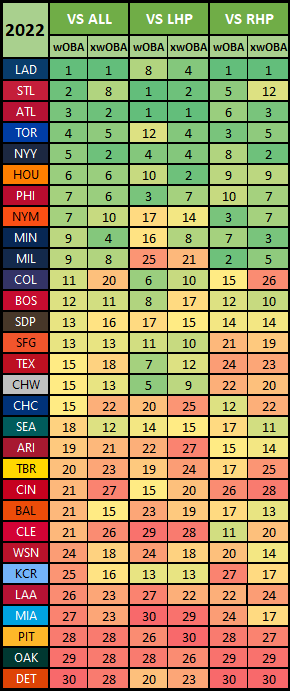
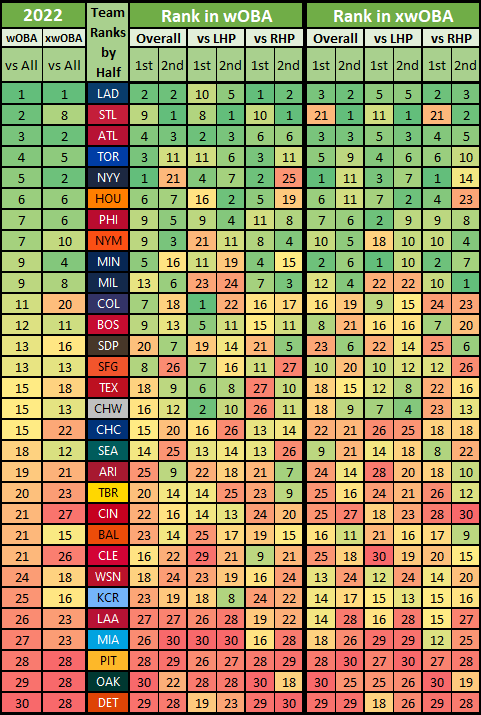
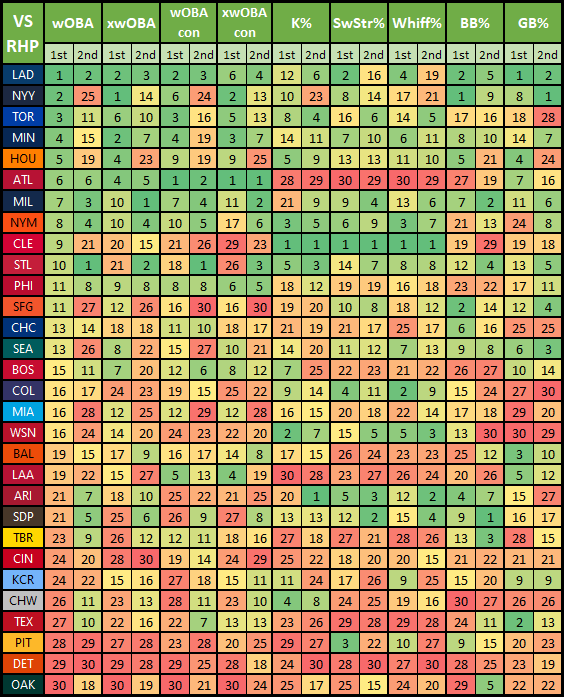
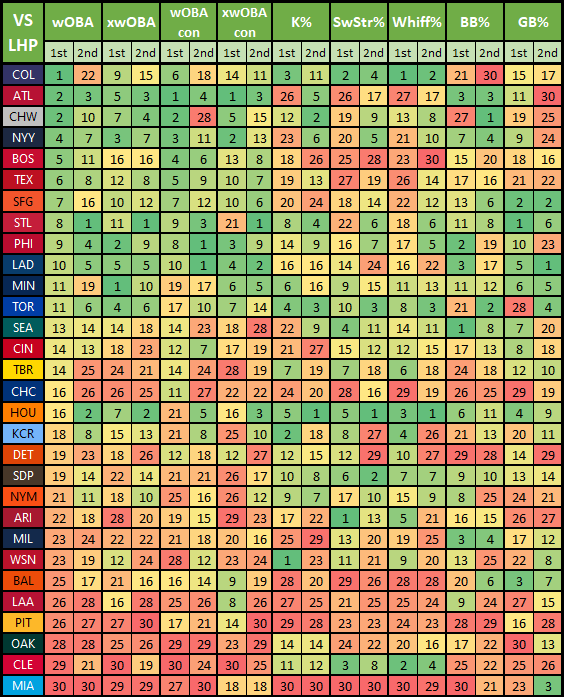
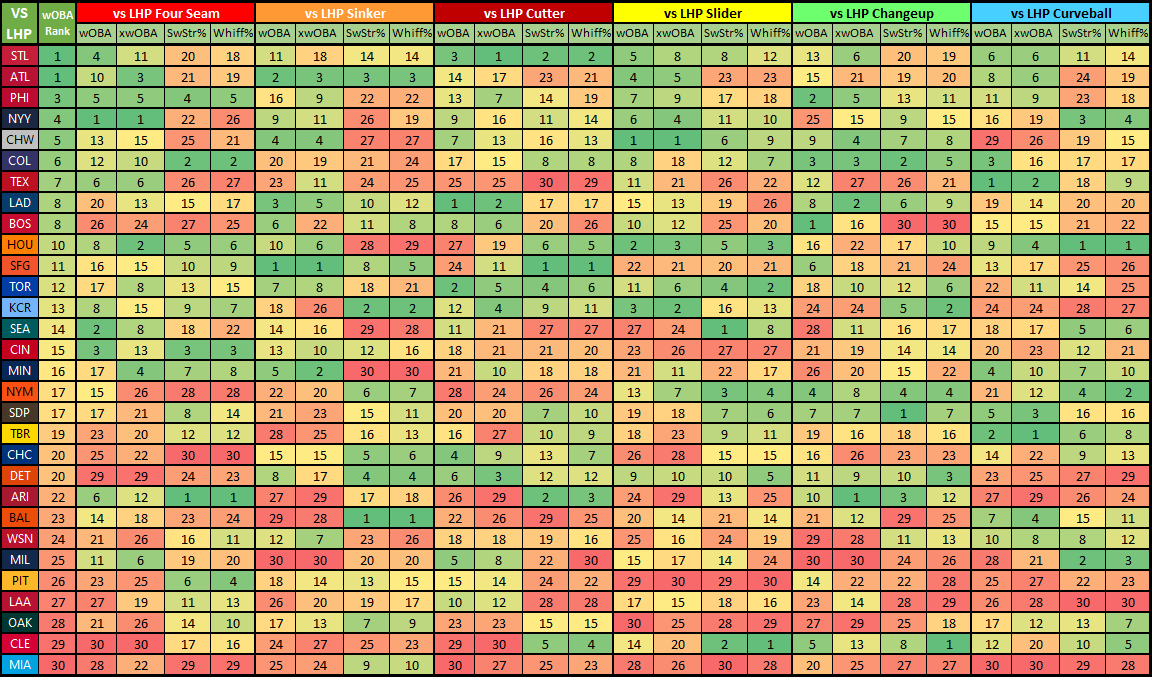
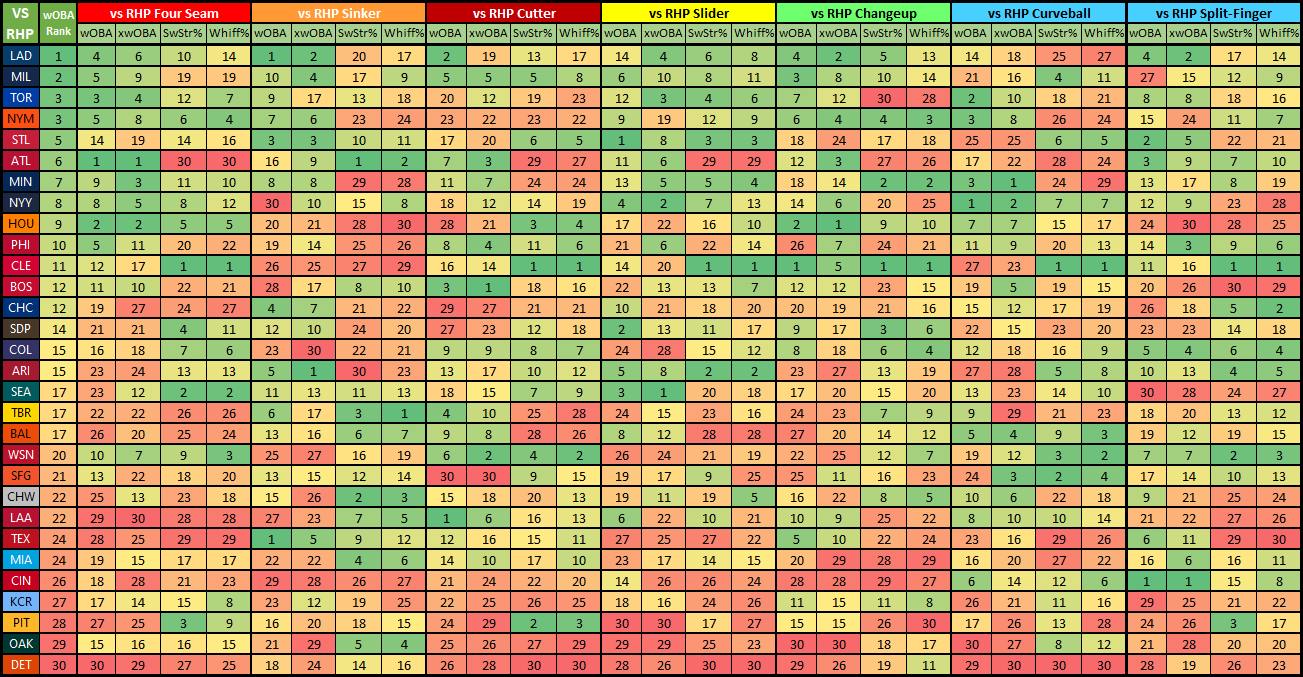
Nicklaus, Great Stuff! Glad you are not in my league.
During the season, I will often consult the Splits Leaderboard in borderline cases, but this takes it to a new level. Thanks.
Not to brag but I once reached the ninth round of Q*bert, so clearly this isn’t my first rodeo when it comes to new levels.
But also, thank you for the kind words! I appreciate you checking it out and am glad you found it useful.